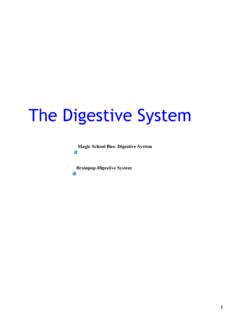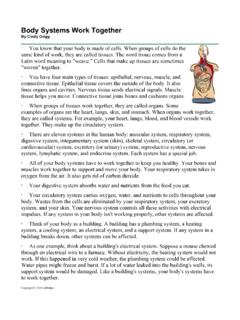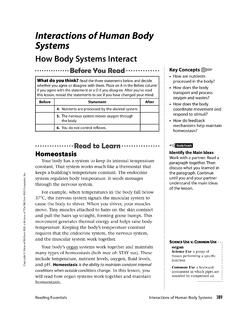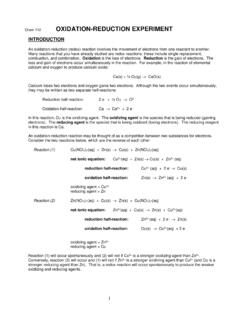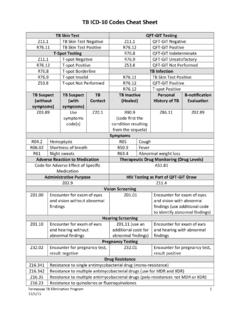Transcription of Unit 5: Anatomy and Physiology for Health and Social Care
1 Edexcel BTEC Level 3 Nationals specification in Health and Social Care Issue 1 June 2010 Edexcel Limited 20101 unit 5: Anatomy and Physiology for Health and Social CareUnit code: R/600/8956 QCF Level 3: BTEC NationalsCredit value: 10 Guided learning hours: 60 Aim and purposeThis unit aims to enable learners to understand aspects of the Anatomy and Physiology of human body systems. Learners will be able to gain an overview of the organisation of the human body before looking at how body systems work together to provide energy for the body. Learners will have the opportunity to investigate how homeostatic mechanisms operate in the introductionThis unit introduces core knowledge of cellular structure and function, and the organisation of the body as a whole, and then builds on this to develop a more detailed knowledge of the fine Anatomy and Physiology of the systems involved in energy will examine the homeostatic mechanisms involved in regulating these systems to maintain Health .
2 Learners will be given the opportunity to undertake practical activities which will require them to take measurements of the cardio-vascular system, the respiratory system and of body temperature, using non-invasive techniques to investigate normal responses to routine variations in body unit provides the core understanding of human Physiology that underpins the study of the specialist Physiology units within this programme. The unit also provides an overview of body functioning that is valuable for anyone working or intending to work in a field relating to Health and Social outcomesOn completion of this unit a learner should:1 Know the organisation of the human body2 Understand the functioning of the body systems associated with energy metabolism3 Understand how homeostatic mechanisms operate in the maintenance of an internal environment4 Be able to interpret data obtained from monitoring routine activities with reference to the functioning of healthy body BTEC Level 3 Nationals specification in Health and Social Care Issue 1 June 2010 Edexcel Limited 20102 unit content1 Know the organisation of the human bodyOrganisation: cells; tissues; organs; systemsCells: cell membrane, nucleus, cytoplasm.
3 Organelles mitochondria, endoplasmic reticulum (smooth and rough), Golgi apparatus, lysosomeTissues: epithelial: simple (cuboidal, columnar, squamous, ciliated), compound (simple, keratinised)connective: blood, cartilage, bone, areolar, adiposemuscle: striated, non-striated, cardiacnervous: neurones, neorogliaexamples of where each tissue type might be foundBody organs: location of heart, lungs, brain, stomach, liver, pancreas, duodenum, ileum, colon, kidneys, bladder, ovaries/testes, uterus; structure and function of the skinSystems: gross structure of cardiovascular, respiratory , digestive , renal, nervous, endocrine, reproductive, lymphatic, musculo-skeletal, immuneMain functions of systems: overall function of each system, eg digestion of food materials, maintenance of oxygen supply, transport and supply of materials to cells, receptors of information from the environment, co-ordination, eliminating waste products, reproduction; overview of interactions of the different structures within each system2 Understand the functioning of the body systems associated with energy metabolismEnergy: forms, eg chemical, heat, sound, electrical, lightEnergy laws: conservation of energy; transformation of energyEnergy metabolism: role of energy in the body; anabolism and catabolism; activities involved in supplying energy to the cells of the body roles of cardiovascular, respiratory and digestive systemsCardiovascular system: heart structure, cardiac cycle, heart rate, stroke volume, blood pressure, blood vessels arteries, arterioles, capillaries, venules, veins; pulmonary and systemic circulation; structure and function of the bloodRespiratory system: role of air passages in nose; structure and functions of trachea, bronchi, lungs- bronchial tree, alveoli; role of ciliated epithelial tissue; respiratory muscles intercostal muscles, diaphragm.
4 Ventilation, gaseous exchange, diffusionDigestive system: alimentary canal oesophagus, stomach, duodenum, ileum, colon; liver, pancreas, salivary glands; role of digestive system in breakdown and absorption of food materials, ingestion, peristalsis, digestion, absorption, egestionRole of enzymes in digestion: amylases, proteases, lipases; sites of secretion; role in digestionMajor products of digestion: peptides and amino acids, sugars, glycerol and fatty acids; roles in the body; storage of excess fats and carbohydrates; deamination of excess proteins and the fate of end products; role of the liver; role of the kidneysAbsorption of food: into blood; into lacteals; role of villi and microvilli 3 Edexcel BTEC Level 3 Nationals specification in Health and Social Care Issue 1 June 2010 Edexcel Limited 20103 Understand how homeostatic mechanisms operate in the maintenance of an internal environmentHomeostasis: definition of homeostasis, internal environment, concept of negative feedback as a regulatory mechanismHomeostatic mechanisms for regulation of:heart rate: roles of internal receptors, autonomic nervous system-sympathetic and parasympathetic nerve supply, cardiac centre, sinoatrial node; effects of increased body temperature and adrenaline on heart ratebreathing rate: roles of internal receptors, autonomic nervous system sympathetic and parasympathetic nerve supply, respiratory centre, diaphragm and intercostal musclesbody temperature: production of heat by the body, eg through metabolic processes; loss of heat by the body radiation, conduction, convection, evaporation.
5 Roles of hypothalamus, autonomic nervous system sympathetic and parasympathetic, skin role of arterioles and sweat glands; effects of shivering; implications of surface area to volume ratios, eg in the care of babies; feverblood glucose levels: roles of pancreas, liver, insulin, glucagon4 Be able to interpret data obtained from monitoring routine activities with reference to the functioning of healthy body systemsMeasurements: pulse rate, breathing rate, temperature; normal values and ranges; safe practice in taking measurements, recognition of factors affecting reliability of measurementsNormal variations: as measured at rest and then at intervals during recovery following a standard exercise test, eg Harvard step testData presentation and interpretation: graphs and charts; supporting explanations of collated data Edexcel BTEC Level 3 Nationals specification in Health and Social Care Issue 1 June 2010 Edexcel Limited 20104 Assessment and grading criteriaIn order to pass this unit , the evidence that the learner presents for assessment needs to demonstrate that they can meet all the learning outcomes for the unit .
6 The assessment criteria for a pass grade describe the level of achievement required to pass this and grading criteriaTo achieve a pass grade the evidence must show that the learner is able to:To achieve a merit grade the evidence must show that, in addition to the pass criteria, the learner is able to:To achieve a distinction grade the evidence must show that, in addition to the pass and merit criteria, the learner is able to:P1 outline the functions of the main cell components[RL6; SM2; SM5; EP4]P2 outline the structure of the main tissues of the body[IE2; TW1; SM2; SM5]P3 outline the gross structure of all the main body systems[CT1; RL6; SM2; SM5]P4 explain the Physiology of two named body systems in relation to energy metabolism in the body[CT4; RL6; SM2; SM5]M1 discuss the role of energy in the bodyD1 analyse how two body systems interrelate to perform a named function/functionsP5 explain the concept of homeostasis [CT4; SM2; SM5]M2 discuss the probable homeostatic responses to changes in the internal environment during exerciseD2 evaluate the importance of homeostasis in maintaining the healthy functioning of the follow guidelines to interpret collected data for heart rate, breathing rate and temperature before and after a standard period of exercise.
7 [CT4; TW2; SM2; SM5]M3 present data collected before and after a standard period of exercise with reference to : This summary references where applicable, in the square brackets, the elements of the personal, learning and thinking skills which are embedded in the assessment of this unit . By achieving the criteria, learners will have demonstrated effective application of the referenced elements of the skills. KeyIE independent enquirersCT creative thinkersRL reflective learners TW team workersSM self-managersEP effective participators5 Edexcel BTEC Level 3 Nationals specification in Health and Social Care Issue 1 June 2010 Edexcel Limited 2010 Essential guidance for tutorsDeliveryLearners need to develop an awareness of the human body and how it functions at various levels, as well as an understanding of how cells, tissues, organs and systems work together in the healthy functioning of the body. Learners need to develop an understanding of the organisation of the body as a whole in order to gain a firm basis for further studies or work within the Health and Social care sectors.
8 However, a detailed understanding of all the systems of the body is not required for this unit . An overview of cellular structure is required and learners may wish to investigate this using practical strategies such as prepared histology slides and simple microscope may wish to investigate the organisation of the body at cellular and tissue level through small-group work and to present their findings. Learners should be given the opportunity to investigate and research the gross Anatomy and function of all body systems using appropriate methods, and to discuss these in order to reinforce their need to investigate in more detail the three systems of the body that are involved in providing the necessary requirements for the release of energy within cells. The opportunity to include a brief investigation into the physical aspects of energy should be embedded in order for learners to fully understand the nature of energy and its role within the body. When investigating these three systems learners should initially be given an overview of the systems and then directed to discover in more detail the specific components of the three systems which link to energy production.
9 For the cardiovascular system this should include the role of blood and, in particular, the transport of materials within the plasma and haemoglobin. The focus for the respiratory system should be on the role of gaseous exchange with the opportunity to differentiate between internal and external respiration. For the digestive system learners need to understand the structure and function of the system including an overview of digestion, the role of enzymes, absorption and need the opportunity to appreciate the importance of homeostasis and homeostatic mechanisms within the body. This could be linked to possible scenarios of what happens when homeostasis does not function correctly. Discussion of homeostasis and possible metabolic uses of the major products of digestion can be linked to diet, growth, exercise and weight change. Measurement of body temperature and breathing rate does not require more than standard clinical observation techniques and equipment available through a retailerGuidance on the safe use of appropriate techniques should be provided for the practical activities, although learners should be encouraged to devise their own suitable exercise formats as appropriate.
10 The standard exercise test used to generate the data for assessment needs to include a moderate level of exertion for learners carried out for a periods of 10 to 15 minutes, subject to individual capabilities. Examples should all follow appropriate Health and safety is recommended that learners take measurements before the exercise, immediately after cessation of the exercise, two to three further readings in the first five minutes of the recovery period, and then at longer intervals until readings have returned to pre-exercise should be given an appropriate amount of time to both plan and carry out their practical should be encouraged to be reflective and to develop their own independent enquiry at all times. They should also be encouraged to participate effectively within groups and to accept and provide BTEC Level 3 Nationals specification in Health and Social Care Issue 1 June 2010 Edexcel Limited 20106 Outline learning planThe outline learning plan has been included in this unit as guidance and can be used in conjunction with the programme of suggested outline learning plan demonstrates one way in planning the delivery and assessment of this unit .











